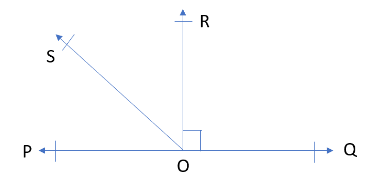
In the figure, POQ is a line. Ray OR is perpendicular to line PQ. OS is another ray lying between rays OP and OR. Prove that
$\angle ROS = \dfrac{1}{2}(\angle QOS - \angle POS).$


Answer
570k+ views
Hint: To solve this question, we have been given a figure, where, $\angle ROQ = 90^\circ $ and $\angle ROP = 90^\circ $ then, on keeping $\angle ROP$ and $\angle ROQ$ equal, because the angles are equals to \[90^\circ ,\] then solving further we will get the required expression.
Complete step-by-step answer:
We have been given a figure, in it POQ is a line. We have also been given that the ray OR is perpendicular to line PQ. And, OS is another ray lying between rays OP and OR. We need to prove that $\angle ROS = \dfrac{1}{2}(\angle QOS - \angle POS).$
So, it is given that ray OR is perpendicular to line PQ, i.e., $OR \bot PQ$
From the figure we get that, $\angle ROP = 90^\circ $ and $\angle ROQ = 90^\circ $
So, we can put, $\angle ROP = \angle ROQ$ (because both the angles are equals to \[90^\circ \])
Since, it is given that OS is another ray lying between rays OP and OR.
$ \Rightarrow \angle ROP = \angle POS + \angle ROS$
Now, on putting, $\angle ROQ$in place of $\angle ROP$, because both the angles are equal to each other, we get
$\angle POS + \angle ROS = \angle ROQ$
Since in the question, it is given that, ray OR is perpendicular to line PQ.
$ \Rightarrow \angle POS + \angle ROS = \angle QOS - \angle ROS$
Now, on rearranging the above equation, we get
$2\angle ROS = \angle QOS - \angle POS$
$ \Rightarrow \angle ROS = \dfrac{1}{2}\angle QOS - \angle POS$
Hence proved, $\angle ROS = \dfrac{1}{2}(\angle QOS - \angle POS).$
Note: Before solving, students should carefully observe the given figure. And then using the given information, solve further. To solve these types of question, where we are supposed to prove something, it is usually advisable to start with one side i.e., either start from L.H.S or R.H.S., then eventually we can prove the equation.
Complete step-by-step answer:
We have been given a figure, in it POQ is a line. We have also been given that the ray OR is perpendicular to line PQ. And, OS is another ray lying between rays OP and OR. We need to prove that $\angle ROS = \dfrac{1}{2}(\angle QOS - \angle POS).$
So, it is given that ray OR is perpendicular to line PQ, i.e., $OR \bot PQ$
From the figure we get that, $\angle ROP = 90^\circ $ and $\angle ROQ = 90^\circ $
So, we can put, $\angle ROP = \angle ROQ$ (because both the angles are equals to \[90^\circ \])
Since, it is given that OS is another ray lying between rays OP and OR.
$ \Rightarrow \angle ROP = \angle POS + \angle ROS$
Now, on putting, $\angle ROQ$in place of $\angle ROP$, because both the angles are equal to each other, we get
$\angle POS + \angle ROS = \angle ROQ$
Since in the question, it is given that, ray OR is perpendicular to line PQ.
$ \Rightarrow \angle POS + \angle ROS = \angle QOS - \angle ROS$
Now, on rearranging the above equation, we get
$2\angle ROS = \angle QOS - \angle POS$
$ \Rightarrow \angle ROS = \dfrac{1}{2}\angle QOS - \angle POS$
Hence proved, $\angle ROS = \dfrac{1}{2}(\angle QOS - \angle POS).$
Note: Before solving, students should carefully observe the given figure. And then using the given information, solve further. To solve these types of question, where we are supposed to prove something, it is usually advisable to start with one side i.e., either start from L.H.S or R.H.S., then eventually we can prove the equation.
Recently Updated Pages
Master Class 10 General Knowledge: Engaging Questions & Answers for Success

Master Class 10 Science: Engaging Questions & Answers for Success

Master Class 10 Social Science: Engaging Questions & Answers for Success

Master Class 10 Maths: Engaging Questions & Answers for Success

Master Class 10 English: Engaging Questions & Answers for Success

Master Class 10 Computer Science: Engaging Questions & Answers for Success

Trending doubts
What is BLO What is the full form of BLO class 8 social science CBSE

Citizens of India can vote at the age of A 18 years class 8 social science CBSE

Full form of STD, ISD and PCO

Right to vote is a AFundamental Right BFundamental class 8 social science CBSE

Summary of the poem Where the Mind is Without Fear class 8 english CBSE

What are gulf countries and why they are called Gulf class 8 social science CBSE





